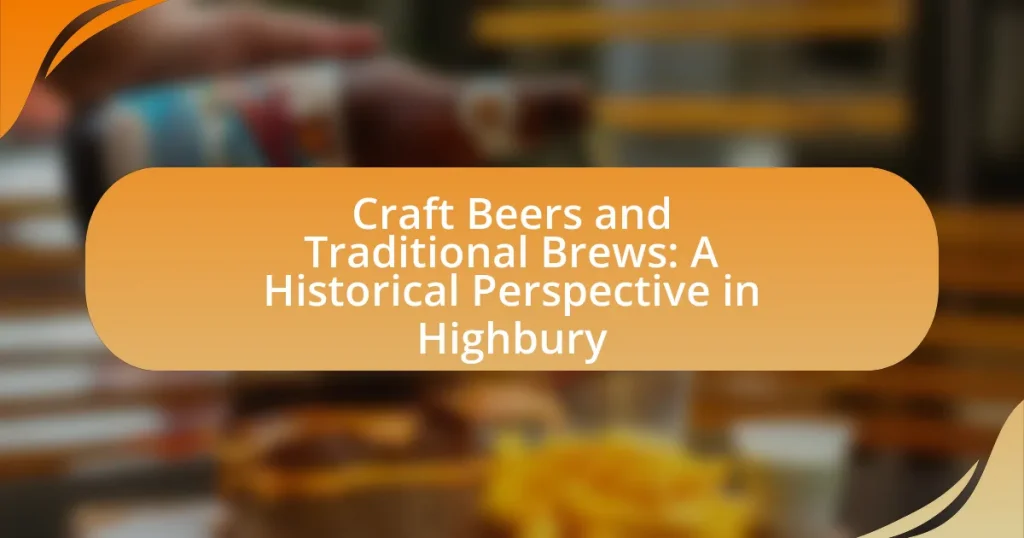Craft beers and traditional brews in Highbury represent a dynamic intersection of artisanal brewing and historical practices. The craft beer movement, which began in the early 2000s, has led to the emergence of independent breweries that prioritize unique flavors and local ingredients, contrasting with mass-produced traditional brews that reflect the region’s brewing heritage. Key developments in Highbury’s brewing history, including the impact of the Industrial Revolution and Prohibition, have shaped the current landscape, where local breweries play a vital role in preserving cultural traditions while adapting to modern consumer preferences. The article explores the evolution of brewing in Highbury, the significance of local ingredients, and the challenges faced by craft breweries today, providing a comprehensive overview of the area’s rich beer culture.

What are Craft Beers and Traditional Brews in Highbury?
Craft beers in Highbury are small-batch, artisanal beers produced by independent breweries, emphasizing unique flavors and brewing techniques. Traditional brews, on the other hand, refer to classic beer styles that have been historically brewed in the region, often following age-old recipes and methods. Highbury’s craft beer scene has grown significantly, with local breweries like the Highbury Brewery showcasing innovative flavors, while traditional brews maintain cultural heritage, reflecting the area’s brewing history. This combination of craft and tradition contributes to a diverse beer culture in Highbury, appealing to both modern tastes and historical appreciation.
How did the craft beer movement begin in Highbury?
The craft beer movement in Highbury began in the early 2000s, driven by a growing interest in artisanal brewing and local ingredients. This shift was marked by the establishment of small, independent breweries that focused on quality, flavor, and traditional brewing methods, contrasting with mass-produced beers. Notably, the opening of local breweries such as the Highbury Brewery in 2005 exemplified this trend, as it catered to the community’s desire for unique and locally sourced beer options. The movement gained momentum through beer festivals and local markets, fostering a culture of craft beer appreciation among residents.
What historical events influenced the rise of craft breweries in Highbury?
The rise of craft breweries in Highbury was significantly influenced by the deregulation of the British beer market in the late 20th century, particularly the Beer Orders of 1989. This legislation aimed to increase competition by allowing smaller breweries to enter the market, which led to a resurgence of local brewing traditions. Additionally, the growing consumer demand for unique and locally sourced products in the 2000s further propelled the craft beer movement in Highbury, as residents sought alternatives to mass-produced beers. The combination of these regulatory changes and shifting consumer preferences created a fertile environment for the establishment and growth of craft breweries in the area.
How have local ingredients shaped the brewing culture in Highbury?
Local ingredients have significantly shaped the brewing culture in Highbury by fostering unique flavors and styles that reflect the region’s agricultural heritage. The use of locally sourced hops, barley, and other grains has allowed brewers to create distinctive craft beers that resonate with the community’s identity. For instance, Highbury’s proximity to farms enables brewers to incorporate seasonal ingredients, enhancing the freshness and quality of their products. This practice not only supports local agriculture but also promotes a sense of pride among brewers and consumers alike, as evidenced by the increasing popularity of local breweries that emphasize their use of regional ingredients in their offerings.
What distinguishes craft beers from traditional brews?
Craft beers are distinguished from traditional brews primarily by their production methods, ingredients, and scale. Craft beers are typically produced by small, independent breweries that emphasize quality, flavor, and unique brewing techniques, often using innovative ingredients and traditional methods. In contrast, traditional brews are usually mass-produced by larger breweries, focusing on consistency and cost-effectiveness, often using adjuncts like corn or rice to reduce production costs. According to the Brewers Association, a brewery must produce less than six million barrels annually and be independently owned to be classified as a craft brewery, highlighting the scale difference.
What are the key characteristics of craft beers?
Craft beers are characterized by their small-scale production, unique flavors, and emphasis on quality ingredients. Unlike mass-produced beers, craft beers often feature innovative brewing techniques and a diverse range of styles, including IPAs, stouts, and sours. The Brewers Association defines craft breweries as those producing less than six million barrels annually, focusing on traditional methods and local sourcing. This commitment to craftsmanship results in distinctive taste profiles, often enhanced by the use of specialty malts, hops, and adjuncts, which contribute to the overall complexity and character of the beer.
How do traditional brews reflect the history and culture of Highbury?
Traditional brews in Highbury reflect the area’s history and culture by showcasing local ingredients, brewing techniques, and community traditions. Historically, Highbury’s brewing practices have evolved from home brewing in the 19th century to the establishment of local breweries that emphasize regional flavors. For instance, the use of locally sourced hops and grains in traditional recipes highlights the agricultural heritage of the region. Additionally, community events centered around brewing, such as festivals and tastings, foster social connections and celebrate local identity. These elements illustrate how traditional brews serve as a cultural artifact, embodying the historical narrative and communal spirit of Highbury.
Why is the historical perspective important for understanding Highbury’s brewing scene?
The historical perspective is crucial for understanding Highbury’s brewing scene because it reveals the evolution of brewing practices and local beer culture over time. This perspective highlights how historical events, such as the Industrial Revolution and changes in legislation, influenced the types of beers produced and the brewing techniques employed in Highbury. For instance, the establishment of local breweries in the 19th century laid the foundation for the craft beer movement, showcasing a shift from mass production to artisanal brewing. Understanding these historical contexts allows for a deeper appreciation of the unique characteristics of Highbury’s current brewing landscape, including the revival of traditional methods and the emphasis on local ingredients.
How does the history of brewing in Highbury compare to other regions?
The history of brewing in Highbury is characterized by a smaller scale and more localized production compared to other regions known for larger brewing industries, such as Burton-on-Trent or Munich. Highbury’s brewing scene has been influenced by its proximity to London, where craft beer movements have gained traction since the late 20th century, leading to a rise in microbreweries and artisanal brewing practices. In contrast, regions like Burton-on-Trent have a long-standing reputation for large-scale brewing, particularly of pale ales, due to their unique water sources and established brewing traditions dating back to the 19th century. This distinction highlights Highbury’s focus on craft and community-oriented brewing, which contrasts with the industrial scale and historical significance of brewing in other areas.
What role do local breweries play in preserving Highbury’s brewing heritage?
Local breweries play a crucial role in preserving Highbury’s brewing heritage by maintaining traditional brewing methods and recipes that reflect the area’s historical practices. These establishments often source local ingredients and engage in community-focused brewing, which fosters a connection to Highbury’s past. For instance, many local breweries recreate historical styles that were once popular in the region, thereby educating patrons about the local brewing history. Additionally, events such as brewery tours and tastings often highlight the significance of Highbury’s brewing legacy, ensuring that this cultural heritage is celebrated and passed on to future generations.
What are the key developments in Highbury’s brewing history?
Highbury’s brewing history is marked by several key developments, including the establishment of local breweries in the 19th century, the rise of craft brewing in the late 20th century, and the integration of traditional brewing methods with modern techniques. The first significant brewery in Highbury, the Highbury Brewery, was founded in 1830, contributing to the area’s local economy and culture. In the 1980s, the craft beer movement gained momentum, leading to the opening of several microbreweries that emphasized quality and unique flavors. This resurgence of interest in traditional brewing practices has resulted in a blend of historical and contemporary brewing styles, reflecting Highbury’s evolving identity within the craft beer landscape.
How did the Industrial Revolution impact brewing in Highbury?
The Industrial Revolution significantly transformed brewing in Highbury by introducing mechanization and improved transportation methods. Mechanization allowed for larger-scale production, which increased efficiency and reduced labor costs, enabling local breweries to produce beer more rapidly and in greater quantities. Additionally, advancements in transportation, such as the expansion of railways, facilitated the distribution of beer beyond local markets, allowing Highbury brewers to reach a wider audience. This period also saw the introduction of new brewing techniques and ingredients, which contributed to the diversification of beer styles available to consumers.
What technological advancements changed the brewing process?
Technological advancements that changed the brewing process include the introduction of refrigeration, pasteurization, and automated brewing systems. Refrigeration allowed for precise temperature control during fermentation, enhancing flavor consistency and quality. Pasteurization, developed by Louis Pasteur in the 19th century, improved shelf life and safety by eliminating harmful microorganisms. Automated brewing systems, which emerged in the late 20th century, streamlined production, reduced labor costs, and increased efficiency, enabling breweries to scale up operations while maintaining quality. These advancements collectively transformed brewing into a more scientific and efficient process, leading to the diverse craft beer landscape seen today.
How did the Industrial Revolution affect local breweries and their production?
The Industrial Revolution significantly transformed local breweries and their production methods. It introduced mechanization, which allowed breweries to increase their output and efficiency, leading to mass production of beer. For instance, the advent of steam power enabled larger brewing vessels and faster fermentation processes, which reduced production time and costs. Additionally, advancements in refrigeration and transportation improved the quality and distribution of beer, allowing local breweries to reach wider markets. Historical records indicate that by the late 19th century, breweries in regions like Highbury were producing beer on a scale previously unimaginable, with some breweries producing thousands of barrels annually, reflecting the profound impact of industrialization on local brewing practices.
What role did Prohibition play in shaping Highbury’s brewing landscape?
Prohibition significantly altered Highbury’s brewing landscape by forcing many breweries to close or adapt their operations. During the Prohibition era from 1920 to 1933, the production, sale, and transportation of alcoholic beverages were banned in the United States, leading to a decline in traditional brewing practices. Many local breweries in Highbury either ceased operations or pivoted to producing non-alcoholic products, such as soft drinks or near-beer, which was a low-alcohol alternative. This shift not only diminished the variety of craft beers available but also impacted the local economy and community culture centered around brewing. The aftermath of Prohibition saw a slow recovery for breweries, with some re-establishing themselves post-1933, but the landscape had permanently changed, leading to a more fragmented and less diverse brewing scene in Highbury.
How did local breweries adapt during Prohibition?
Local breweries adapted during Prohibition by diversifying their product offerings and shifting to non-alcoholic beverages. Many breweries began producing soft drinks, near-beer (a low-alcohol beer), and malt extract, which could be legally sold. For instance, some breweries transformed into soda manufacturers, capitalizing on their existing infrastructure and distribution networks. This adaptation was crucial for survival, as it allowed them to maintain operations and retain employees during the dry years from 1920 to 1933 when the 18th Amendment prohibited the production and sale of alcoholic beverages in the United States.
What were the long-term effects of Prohibition on Highbury’s brewing culture?
The long-term effects of Prohibition on Highbury’s brewing culture included a significant decline in local breweries and a shift towards illicit brewing practices. During Prohibition, which lasted from 1920 to 1933, many established breweries in Highbury were forced to close or adapt by producing non-alcoholic beverages, leading to a loss of traditional brewing knowledge and community identity. The aftermath saw a slow recovery, with the remaining breweries facing challenges in re-establishing their market presence, as consumer preferences had shifted and competition from larger, industrial breweries increased. This period also fostered a culture of home brewing and underground operations, which persisted even after Prohibition ended, influencing the craft beer movement that emerged later in Highbury.
How have recent trends influenced the craft beer scene in Highbury?
Recent trends have significantly influenced the craft beer scene in Highbury by increasing consumer demand for locally sourced and unique brews. This shift has led to a rise in the number of microbreweries and taprooms in the area, with establishments like the Highbury Brewery showcasing innovative flavors and brewing techniques. Additionally, the trend towards sustainability has prompted many breweries to adopt eco-friendly practices, such as using organic ingredients and reducing waste. Data from the British Beer and Pub Association indicates that the craft beer market has grown by over 30% in the past five years, reflecting a broader national trend that has also impacted Highbury’s local scene.
What are the current popular styles of craft beer in Highbury?
The current popular styles of craft beer in Highbury include IPAs (India Pale Ales), stouts, and pale ales. IPAs are favored for their hoppy flavors and aromas, often showcasing local and international hop varieties. Stouts, known for their rich, dark profiles, are appreciated for their roasted malt characteristics, while pale ales offer a balanced taste with moderate hop bitterness. These styles reflect the broader trends in the craft beer movement, which emphasizes quality ingredients and innovative brewing techniques.
How have consumer preferences shifted in recent years?
Consumer preferences have shifted towards craft beers over traditional brews in recent years. This change is evidenced by the increasing market share of craft breweries, which grew from 5% of the total beer market in 2011 to approximately 23% by 2022, according to the Brewers Association. Additionally, consumers are increasingly valuing unique flavors, local sourcing, and artisanal production methods, leading to a decline in the consumption of mass-produced beers. This trend reflects a broader movement towards personalization and quality in food and beverage choices.

What are the future prospects for craft beers and traditional brews in Highbury?
The future prospects for craft beers and traditional brews in Highbury appear promising, driven by a growing consumer preference for unique and locally sourced beverages. Recent trends indicate that the craft beer market in the UK has been expanding, with a reported growth rate of 7% annually, reflecting a shift towards artisanal products. Additionally, Highbury’s vibrant community and increasing number of microbreweries contribute to a supportive environment for innovation and experimentation in brewing. This local enthusiasm is further evidenced by the rise in craft beer festivals and tasting events, which attract both residents and visitors, enhancing the visibility and appreciation of craft and traditional brews in the area.
How can local breweries innovate while respecting tradition?
Local breweries can innovate while respecting tradition by incorporating modern brewing techniques and ingredients without compromising the foundational recipes and methods that define their heritage. For example, breweries can experiment with new hop varieties or fermentation processes while still adhering to traditional styles, such as lagers or ales, that have historical significance in their region. This approach allows them to create unique flavor profiles that appeal to contemporary tastes while honoring the brewing practices that have been passed down through generations. Additionally, local breweries can engage with their communities by sourcing ingredients from local farms, thereby supporting local agriculture and enhancing the authenticity of their products. This balance of innovation and tradition not only preserves the cultural significance of brewing but also fosters a sense of community and sustainability.
What new brewing techniques are emerging in Highbury?
New brewing techniques emerging in Highbury include the use of innovative fermentation methods, such as wild fermentation and barrel-aging, which enhance flavor complexity. Additionally, local breweries are increasingly adopting techniques like hop bursting and dry hopping to intensify aroma and taste. These methods reflect a growing trend towards experimentation and the incorporation of local ingredients, which is supported by the rise of craft beer culture in the area.
How can breweries balance craft and traditional brewing methods?
Breweries can balance craft and traditional brewing methods by integrating innovative techniques while respecting historical practices. This approach allows breweries to create unique flavors and styles that appeal to modern consumers, while still honoring the foundational brewing methods that have been used for centuries. For instance, many breweries utilize traditional ingredients and fermentation processes but experiment with new hop varieties or adjuncts to enhance their offerings. This balance is supported by the growing trend of craft beer, which has seen a 23% increase in production from 2019 to 2020, indicating consumer interest in both innovation and tradition. By maintaining this dual focus, breweries can attract a diverse customer base and preserve the rich heritage of brewing.
What challenges do craft breweries face in Highbury today?
Craft breweries in Highbury today face significant challenges, including increased competition, regulatory hurdles, and rising operational costs. The craft beer market has become saturated, with numerous breweries vying for consumer attention, making it difficult for individual establishments to stand out. Additionally, stringent regulations regarding alcohol production and sales can complicate operations and limit growth opportunities. Rising costs associated with ingredients, labor, and utilities further strain profitability, forcing breweries to innovate and adapt to maintain their market position.
How does competition affect the craft beer market in Highbury?
Competition significantly influences the craft beer market in Highbury by driving innovation and improving product quality. As multiple breweries vie for consumer attention, they are compelled to differentiate their offerings, leading to unique flavors and brewing techniques. This competitive landscape has resulted in a diverse range of craft beers available to consumers, enhancing their choices. Additionally, competition often leads to better pricing strategies, as breweries adjust their prices to attract customers while maintaining profitability. According to a report by the Brewers Association, the craft beer segment has seen a growth rate of over 4% annually, indicating that competition fosters a dynamic market environment that benefits both producers and consumers.
What regulatory issues impact brewing in Highbury?
Regulatory issues impacting brewing in Highbury include licensing requirements, health and safety regulations, and environmental compliance. The local government mandates that breweries obtain specific licenses to operate legally, which can involve complex applications and fees. Additionally, health and safety regulations require breweries to adhere to strict hygiene standards to ensure product safety, while environmental compliance involves managing waste and emissions according to local laws. These regulations are enforced to maintain public health and safety, as well as to protect the environment, thereby influencing the operational practices of breweries in Highbury.
What tips can aspiring brewers in Highbury consider for success?
Aspiring brewers in Highbury should focus on mastering the brewing process, understanding local tastes, and engaging with the community. Mastering the brewing process involves learning about ingredients, fermentation, and quality control, which are essential for producing high-quality craft beer. Understanding local tastes is crucial, as Highbury has a diverse population with varying preferences; conducting market research can help brewers tailor their offerings. Engaging with the community through events, tastings, and collaborations with local businesses can build a loyal customer base and enhance brand visibility. These strategies are supported by the success of local breweries that have effectively connected with their audience and maintained high standards in their brewing practices.
What resources are available for new craft brewers in Highbury?
New craft brewers in Highbury can access various resources, including local brewing supply shops, community brewing clubs, and educational workshops. These resources provide essential ingredients, equipment, and knowledge necessary for starting a craft brewery. For instance, establishments like the Highbury Brewing Supply offer a range of brewing kits and ingredients tailored for beginners. Additionally, organizations such as the London Brewers Alliance provide networking opportunities and support for new brewers, facilitating knowledge sharing and collaboration within the local brewing community.
How can community engagement enhance a brewery’s success?
Community engagement can significantly enhance a brewery’s success by fostering strong local relationships and increasing brand loyalty. When breweries actively involve the community through events, collaborations, and local sourcing, they create a sense of belonging and support among customers. For instance, a study by the Brewers Association found that breweries that engage with their local communities see a 20% increase in customer retention compared to those that do not. This engagement not only drives sales but also enhances the brewery’s reputation, leading to positive word-of-mouth and attracting new customers.



